Sold Ceramics
Sold Chinese Imari 1700-1800
Tea, Coffee and Chocolate wares
Page 1
Chinese porcelain producers developed new types of decorations in the early 18th century, Chinese Imari being one of them. It is characterised by a combination of underglaze blue and overglaze red and gold. Details are sometimes in black and green enamels. This development was a reaction to the success of Japanese Imari porcelain with a similar colour scheme. Sometimes Chinese imitations are direct copies of Japanese examples but more often Chinese Imari is decorated with typical Chinese motifs that are closely related to the underglaze-blue patterns of the period. However, the use of red and gold makes Chinese Imari more lavish. Landscapes, flowering plants, birds and mythical creatures are recurring motifs. Depictions of humans are less frequent and apart from armorial pieces, European designs are quite rare. The shapes fit into the normal export assortment. Chinese Imari was not only in demand in the West, but also in south-east Asia, India, and the Ottoman Empire. In the VOC (Dutch East India Company, 1602–1799) records it is called 'Chinese-Japanese' and in addition to blue and white and enamelled wares, this was a standard type in the Company's assortment that was bought in Canton until the end of the 18th century.

Sold Ceramics - Sold Chinese Imari 1700-1800 - Tea, Coffee and Chocolate wares - Page 1
Object 2010584
Teapot
China
1700-1720
Height 105 mm (4.13 inch), diameter handle to spout 137 mm (5.93 inch), diameter of footring 50 mm (1.96 inch)
Pear-shaped, ribbed teapot with fluted body on footring. Straight spout, curved C-shaped handle. Domed ribbed cover with a round knob. Chinese Imari, decorated in underglaze blue, overglaze iron-red and gold with a tulip motif flanked by two banana leaves, underglaze blue leafy scrolls and small red flowers. On the spout and handle alternating blue and iron-red stylised motifs. Around the rim a narrow border of underglaze blue ruyi motifs with iron-red and gold accents. Around the rim of the cover aborder with underglaze blue ruyi motifs with iron-red and gold accents.
Tulip mania or tulipomania (Dutch names include: tulpenmanie, tulpomanie, tulpenwoede, tulpengekte and bollengekte) had been a rage The Netherlands on the late 1630s. During that period in the 'Dutch Golden Age' contract prices for bulbs of the recently introduced tulip reached extraordinarily high levels and then suddenly collapsed. At the peak of tulip mania, in February 1637, some single tulip bulbs sold for more than 10 times the annual income of a skilled craftsman. It is generally considered the first recorded speculative bubble. (source: Wikipedia)
For similarly decorated teapots, please see:
- "Een verzameling blauw-en-wit Chinees porselein te Brummen", ANTIEK, IV-3, October 1969, p.123.
- Have a Cup of Tea. Chinese Porcelain and Tea in North-West Germany, (Exhibition catalogue, Isensee Verlag, Oldenburg, 2015), p.79, cat. 35 / Made in China, Porzellan und Teekultur im Nordwesten, (Exhibition catalogue, Isensee Verlag, Oldenburg, 2015), p.113, cat. 35.
Condition: A firing flaw to the spout and the inner footring and a tiny shallow fleabite to the top of the tip of the spout,
References:
Lunsingh Scheurleer 1969, p.123.
Price: Sold.

Sold Ceramics - Sold Chinese Imari 1700-1800 - Tea, Coffee and Chocolate wares - Page 1
Object 2010647
Tea caddy
China
1710-1730
Height including cover 119 mm (4.69 inch), height excluding cover 105 mm (4.13 inch), dimensions 95 mm (3.74 inch) x 51 mm (2.01 inch), diameter of mouthrim 20 mm (0.79 inch), weight with cover 347 grams (12.24 ounce (oz.)), weight cover 20 grams (0.71 ounce (oz.))
Tea caddy of rectangular form with canted corners. Four flat feet at the corners. A flat shoulder and a short upright neck. Chinese Imari, decorated in underglaze blue, overglaze iron-red and gold with scrolls of leafy flowering stems on the sides. On the shoulder, on each side of the filling opening, a fleafy flowering stem. On the cover a river scape and round the sides leafy scrolls.
Condition: Wear to the decoration. Various firing flaws and a chip to the edges. The cover has been restored after being broken in two pieces.
Price: Sold.
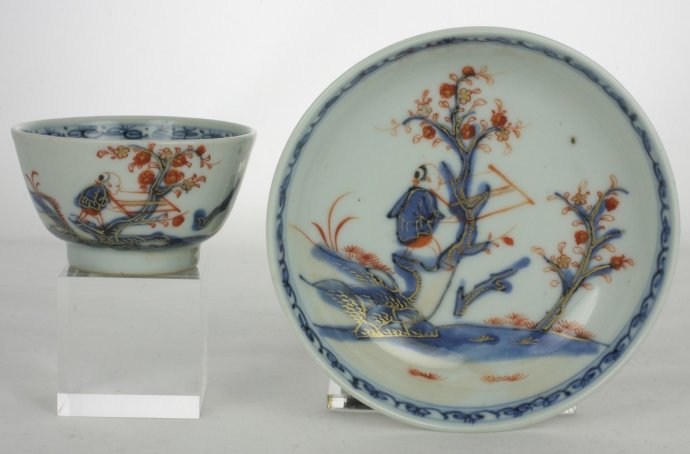
Sold Ceramics - Sold Chinese Imari 1700-1800 - Tea, Coffee and Chocolate wares - Page 1
Object 2010627
Teacup and saucer
China
1730-1750
Height of teacup 40 mm (1.58 inch), diameter of rim 67 mm (2.64 inch), diameter of footring 34 mm (1.34 inch)
Height of saucer 26 mm (1.02 inch), diameter of rim 110 mm (4.33 inch), diameter of footring 65 mm (2.56 inch)
Teacup and saucer on footrings with straight rims. Chinese Imari, decorated in underglaze blue, overglaze iron-red and gold with a figure standing in a tree sawing of branches with a handsaw. On the rims a spiral pattern border. The teacup decorated en suite.
Condition teacup: Perfect.
Condition saucer: A short 10 mm (0.39 inch) glaze hairline only visible on the exterior rim.
Price: Sold.
Not illustrated object 2010635, another identically shaped, sized and decorated, sold teacup and saucer.

Sold Ceramics - Sold Chinese Imari 1700-1800 - Tea, Coffee and Chocolate wares - Page 1
Object 2010428A
Teapot
China
1710-1730
Height 87 mm (3.43 inch), diameter handle to spout 133 mm (5.24 inch), diameter of footring 40 mm (1.58 inch)
Lozenge-shaped teapot on a low, lozenge-shaped footring. The lower body bulges before reverting to a lozenge shape. Straight spout with a curved C-shaped handle. A lozenge shaped cover with round knob. Chinese Imari, decorated in underglaze blue, overglaze iron-red and gold with flowering plants in low relief and two butterflies in flight.
Objects decorated in a moulded low relief could have been made in a specialised workshop producing for export.
Condition: A tiny fleabite to the tip of the spout, a wide hairline to the underside of the body and glaze frits to the edges of the cover and knob.
Price: Sold.
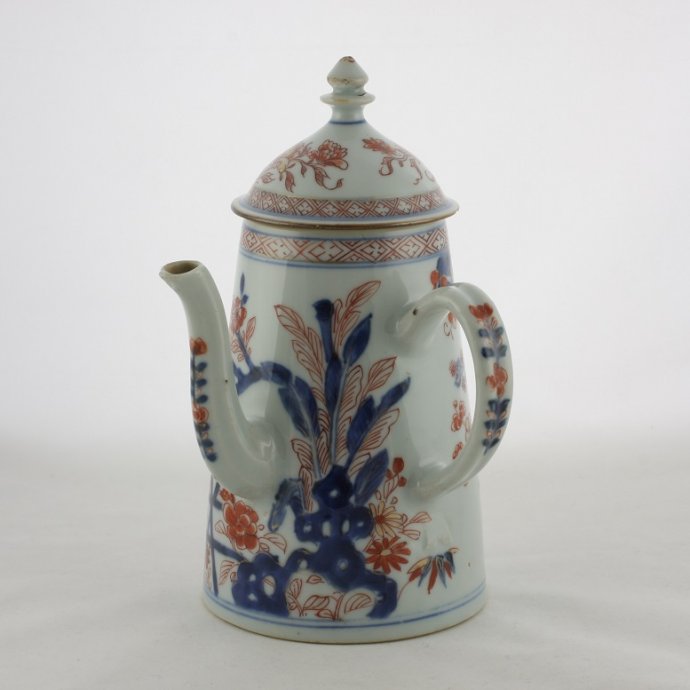
Sold Ceramics - Sold Chinese Imari 1700-1800 - Tea, Coffee and Chocolate wares - Page 1
Object 2010711
Coffee pot
China
1725-1740
Height 190 mm (7.48 inch), diameter of mouthrim 65 mm (2.56 inch), diameter of footring 95 mm (3.74 inch)
Tapering cylindrical coffee pot on low footring. The handle placed at an angle to the S-shaped spout. Domed cover with finial and an underglaze brown-edged rim (jia mangkou). Chinese Imari, decorated in underglaze blue, overglaze iron-red and gold with a flower pot on a table filled with the prunus, pine and bamboo. A banana tree growing from pierced rockwork with flowering chrysanthemum and peony plants growing from behind a fence, Round the rim of the pot and the cover a trellis pattern border, On the cover flowering chrysanthemum and peony branches. The handle and spout are decorated with flowering stems.
The decoration with prunus, pine and bamboo is also known as the 'Three Friends of Cold Winter'. The beauty of the flowers and the short blossoming season symbolise moral purity and transient female beauty. (Ströber 2011, p.130)
Condition: To the top of the finial some small frits and two chips to the rim of the cover. A tiny chip to the end of the spout. At about 10 mm (0.39 inch) from the footring a large horizontal hairline.
References:
Price: Sold.

Sold Ceramics - Sold Chinese Imari 1700-1800 - Tea, Coffee and Chocolate wares - Page 1
Object 2010237
Coffee cup
China
1730-1750
Height 68 mm (2.68 inch), diameter of rim 56 mm (2.21 inch), diameter of footring 28 mm (1.10 inch)
Coffee cup with handle on a footring. Chinese Imari, decorated in underglaze blue, overglaze iron-red and gold with rocks, a banana tree, a flowering tree and a table on which two baskets filled with flowering plants. The inside rim is decorated with trellis pattern border with reserves filled with flower heads.
Condition: Perfect.
References:
Price: Sold.
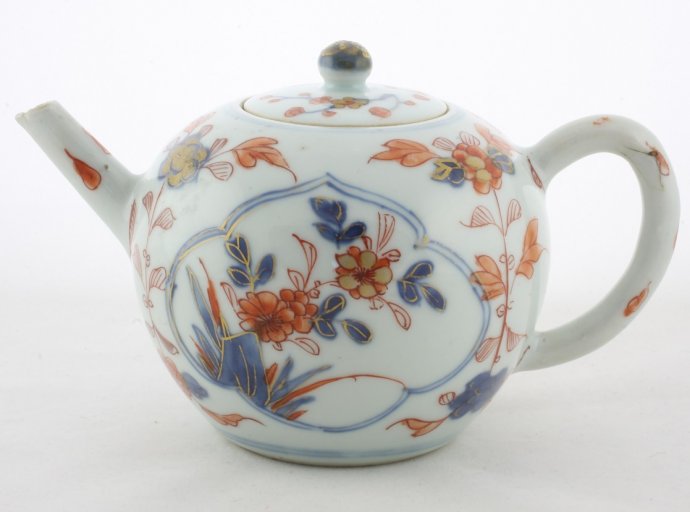
Sold Ceramics - Sold Chinese Imari 1700-1800 - Tea, Coffee and Chocolate wares - Page 1
Object 2011713
Teapot
China
1720-1730
Height including the cover 109 mm (4.29 inch), diameter handle to spout 184 mm (7.24 inch), diameter of mouthrim 57 mm (2.24 inch), diameter of footring 62 mm (2.44 inch), weight with cover 470 grams (16.58 ounce (oz.)), weight cover 37 grams (1.31 ounce (oz.))
Teapot of globular shape on a footring. Straight spout with a curved C-shaped handle. The inlaying flat cover with round knob. Chinese Imari, decorated in underglaze blue, iron-red and gold with two panels filled with flowering plants growing from pierced rockwork. On each side of the panels a single flowering plant. On the spout and handle stylised clouds. Near the attachment of the handle and spout to the body of the teapot a decoration of Artemisia leaves. On the cover two flower sprays.
Chinese Imari usually confined itself to iron-red, underglaze blue, and gold, but occasionally it was enriched with famille verte panels. It was based on the Japanese wares of a similar type made in the Arita kilns and exported to Europe in enormous quantities from the port of Imari in the Southern Island. (Boulay 1984, p.252)
The production of Chinese Imari starting in the early years of the 18th century, reached its peak in the 1720s and 1730s, but became formalised and repetitive in the next decades. Although Chinese Imari was primarily produced for export, it may be noted that there are some pieces in this style in the Palace Museum, Beijing. If these really were part of the imperial collection and not later additions, they are an indication that Chinese Imari was also appreciated by the Chinese an probably served as some kind of "Western" exotic ware. (Jörg & Van Campen 1997, pp.199-200)
Condition: A firing flaw with a missing piece of glaze from which an "U"-shaped hairline originates to the handle. Four firing flaws to the inner mouthrim and a frit to rim of the cover. Two frits to the tip of the spout.
References:
Jörg & Van Campen 1997, pp.199-200
Price: Sold.
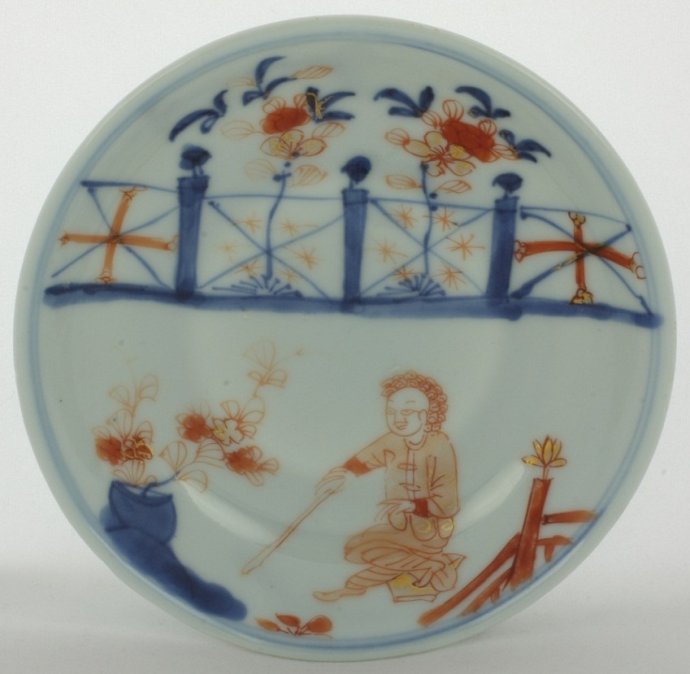
Sold Ceramics - Sold Chinese Imari 1700-1800 - Tea, Coffe and Chocolate wares - Page 1
Object 2010360
Saucer
China
1730-1750
Height 19 mm (0.75 inch), diameter of rim 112 mm (4.01 inch), diameter of footring 59 mm (2.32 inch)
Saucer on footring, slightly everted rim. Chinese Imari, decorated in underglaze blue, overglaze iron-red and gold with a seated figure with a walking cane and a clearly European appearance, hair style and clothing, in the background a fence with flowering plants.
Sotheby's Ca Mau Shipwreck, circa 1725, auction sale catalogue shows an illustration intended to provide instructions for the Chinese porcelain painters on the ways and appearance of unfamiliar foreigners. The foreigner depicted on this saucer is clearly such an unfamiliar (European) foreigner. (Amsterdam 2007, pp.213-214)
Condition: Perfect.
Reference:
Price: Sold.
More pictures of object 2010516, another identically shaped, sized and decorated, sold saucer >>

Sold Ceramics - Sold Chinese Imari 1700-1800 - Tea, Coffee and Chocolate wares - Page 1
Object 2010408
Miniature teapot
China
c.1740
Height 55 mm (4.92 inch), diameter handle to spout 91 mm (7.09 inch), diameter of footring 35 mm (2.56 inch)
Miniature teapot on footring with a straight spout and a C-shaped handle. Domed low cover with a round knob. Chinese Imari, decorated in underglaze blue, overglaze iron-red and gold with flowering chrysanthemum sprays. On the handle two flower sprays and on the spout a single flower spray. A single wide spread chrysanthemum flower head covers almost the entire cover with a few separate leaves.
This teapot was most definitely part of a child's tea set. These toy tea sets were indeed used by children for entertaining guests at tea parties as a common element of their socialization training. Such occasions, however, would have been held under the supervision of adults. (Pardue 2008, p.2)
Condition: Perfect, a tiny firing flaw to the inside of the cover.
Reference:
Price: Sold.

Sold Ceramics - Sold Chinese Imari 1700-1800 - Tea, Coffee and Chocolate wares - Page 1
Object 2010567
Tea caddy
China
1720-1750
Height 114 mm (4.49 inch), dimensions 50 mm (1.97 inch) x 93 mm (3.66 inch)
Tea caddy of rectangular form with canted corners, a flat shoulder with underglaze brown-edged rim (jia mangkou), a short upright neck and cover. The flat base is unglazed. Chinese Imari, decorated in underglaze blue, overglaze iron-red and gold with houses and shrubbery near a river running before a crenulated wall with a fortress, a flagpole and pine and cherry trees . On the shoulder flowering branches. On the side and top of the cover a riverscape with mountains, a pagoda and trees.
The scene of houses and shrubbery near a river running before a crenulated wall is unusual in Chinese Imari ware. This type of decoration, with the brick wall and the pagoda is often referred to as the 'Chinese wall' while others think it is a Chinese fortress within walls. (Gordon 1977, p.47)
For identically decorated objects, please see:
- Collecting Chinese Export Porcelain, (E. Gordon, Universe Books, New York, 1977), p. 47, cat 31.
- Porzellan aus China und Japan. Die Porzellangalerie der Landgrafen von Hessen-Kassel, (Staatliche Kunstsammlungen Kassel, Berlin 1990), p.355, cat. 138.
Condition: The cover is restored, two firing flaws to the neck, a chip and some glaze frits to the edges of the
tea caddy and cover.
References:
Price: Sold.
More pictures of object 2010651, another identically shaped, sized and decorated, sold tea caddy >>

Sold Ceramics - Sold Chinese Imari 1700-1800 - Tea, Coffee and Chocolate wares - Page 1
Object 2011616
Milk jug
China
1760-1780
Height including the cover 166 mm (6.54 inch), diameter 91 mm (3.58 inch), diameter of mouthrim 57 mm, (2.24 inch), diameter of footring 55 mm (2.16 inch), weight with cover 436 grams (15.38 ounce (oz.)), weight cover 51 grams (1.80 ounce (oz.))
Milk jug on footring, pear shaped body, triangular spout at the rim. The C-shaped crossed strap handles are placed opposite the spout. Matching cover with pointed knob. Chinese Imari, decorated in underglaze blue, iron-red and gold with sprays of flowering peony branches around the mouthrim a floral scroll border. On the cover three sprays of flowering branches and around the rim a floral scroll.
Condition: Perfect.
Price: Sold.
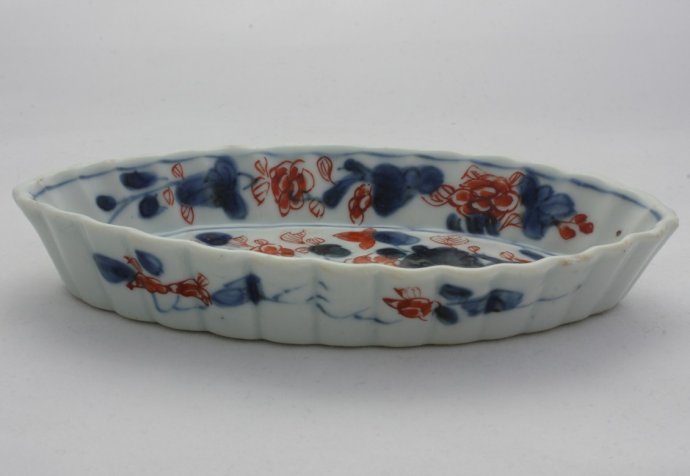
Sold Ceramics - Sold Chinese Imari 1700-1800 - Tea, Coffee and Chocolate wares - Page 1
Object 2010230
Spoon or leak tray
China
1730-1750
Height 20 mm (0.78 inch), dimensions 140 mm (5.51 inch) x 80 mm (3.15 inch)
Oval shaped spoon or leak tray with ribbed sides and a lobed rim on a smooth, unglazed base. Chinese Imari, decorated in underglaze blue, overglaze iron-red and gold with various flowering plants and branches.
A spoon or leak tray was used to protect the surface of luxurious lacquer or painted tea tables, against the influence of a hot teapot or drops running from its spout. If, in certain circles, a special tea table was not at hand it served to protect the furniture or its valuable table-cloth from tea spots. (Volker 1959)
For a similarly decorated spoon- or leak tray, please see:
Condition: A frit and some shallow glaze rough spots to the rim.
References:
Price: Sold.
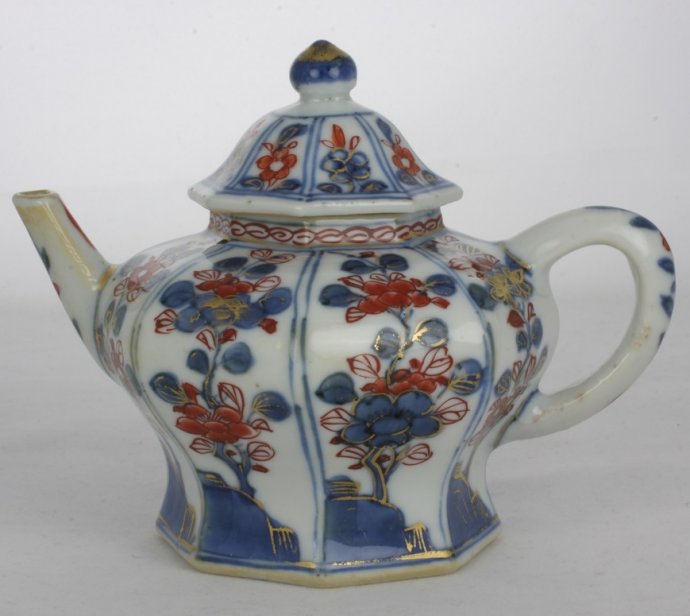
Sold Ceramics - Sold Chinese Imari 1700-1800 - Tea, Coffee and Chocolate wares - Page 1
Object 2010489
Teapot
China
1700-1720
Height 100 mm (3.94 inch), diameter handle to spout 133 mm (5.24 inch), diameter of mouthrim 36 mm (1.41 inch), diameter of footring: 55 mm (2.17 inch)
Teapot, octagonal shaped on an octagonal footring. Straight spout and C-shaped handle. Domed cover with a pointed knob. Chinese Imari, decorated in underglaze blue, overglaze iron-red and gold with flowering plants on each facet. Around the neck a spiral pattern border and on the handle and spout a single flowering stem. The cover is decorated en suite.
For an identically shaped, sized and in underglaze blue decorated teapot, please see:
Condition: Two tiny firing flaw glaze hairlines to the underside of the handle and a tiny chip to the underside of the rim of the cover.
Reference:
Lunsingh Scheurleer 1982/2, cat. 31
Price: Sold.

Sold Ceramics - Sold Chinese Imari 1700-1800 - Tea, Coffee and Chocolate wares - Page 1
Object 2010170
Teacup and saucer
China
1730-1750
Height of teacup 35 mm (1.37 inch), diameter of rim 60 mm (2.36 inch), diameter of footring 30 mm (1.88 inch)
Height of saucer 20 mm (0.78 inch), diameter of rim 105 mm (4.13 inch), diameter of footring 55 mm (2.16 inch)
Teacup and saucer on footrings, sligthly everted rims. Chinese Imari, decorated in underglaze blue, overglaze iron-red and gold with a 'Long Eliza' figure and a rabbit behind a fence in a cerntral roundel. On the sides three medallions, filled with a riverscape, and flower sprays on a iron-red ground with a 'cracked ice' motif in gold. The reverse is undecorated. The teacup is decorated en suite.
The cracked-ice background was one of the new decorating methods in the Kangxi period: leaving certain decorative elements white on a blue background. Nowadays there is a preference for replacing the term 'cracked-ice' by 'erratic paths', after the paths of that name in Chinese gardens, as depicted on paintings and blockprinting from which this motif may derive. (Hartog 1990, p.149)
For objects decorated with a cracked-ice pattern, please see:
- Pronken met Oosters Porselein, exhibition catalogue Gemeentemuseum Arnhem, (S. Hartog, Zwolle, 1990), p.67, cat. 50 & p.89, cat 93.
- Chinese Ceramics in the Collection of the Rijksmuseum Amsterdam, The Ming and Qing Dynasties, (C.J.A. Jörg in collaboration with J. van Campen, Philip Wilson in association with The Rijksmuseum Amsterdam, London 1997), p.113, cat. 112 & 213.
Condition teacup: Perfect.
Condition saucer: Perfect.
References:
Jörg & Van Campen 1997, cat. 112 & 213
Price: Sold.

Sold Ceramics - Sold Chinese Imari 1700-1800 - Tea, Coffee and Chocolate wares - Page 1
Object 2012017
Tea caddy
China
1710-1730
Height including cover 109 mm (4.29 inch), height excluding cover 101 mm (3.98 inch), dimensions 89 mm (3.50 inch) x 52 mm (2.05 inch), diameter of mouthrim 20 mm (0.79 inch), weight with cover 302 grams (10.65 ounce (oz.)), weight cover 18 grams (0.63 ounce (oz.))
Tea caddy of rectangular form with canted corners and a ribbed body. The flat base is unglazed. On the flat top an unglazed cylindrical mouth with a lid fitting (original) cover. Chinese Imari, decorated in underglaze blue, overglaze iron-red and gold. On all sides and the flat shoulders decorated with various flowering plants. Round the shoulder a zig-zag lines pattern border with half flower heads. On the sides of the cover flower sprays and on top a single flowering stem surrounded by a zig-zag lines pattern border with four half flower heads.
For an identically shaped and similarly, in underglaze blue decorated, sold tea caddy, please see:
Condition: Some firing flaws and a frit to the base of the cylindrical mouth.
Price: Sold.
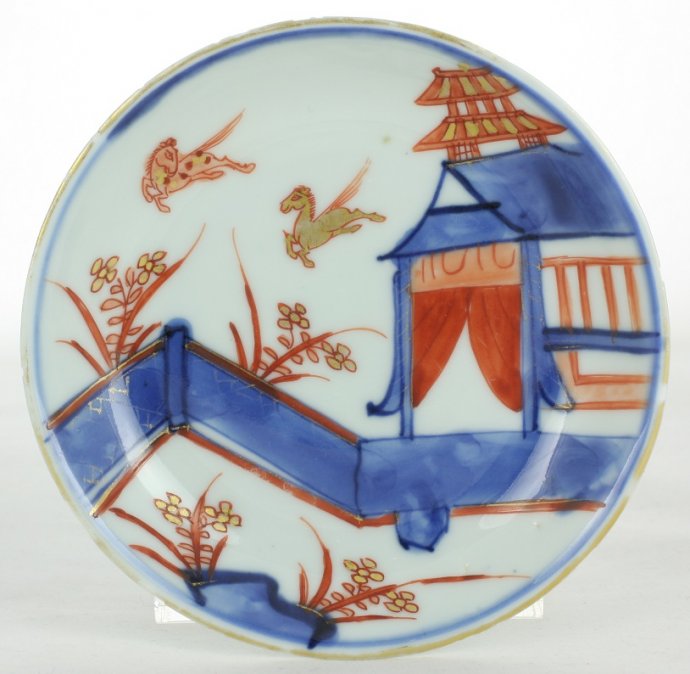
Sold Ceramics - Sold Chinese Imari 1700-1800 - Tea, Coffee and Chocolate wares - Page 1
Object 2010649
Saucer
China
1720-1740
Height 19 mm (0.75 inch), diameter of rim 110 mm (4.33 inch), diameter of footring 59 mm (2.32 inch), weight 72 grams (2.54 ounce (oz.))
Saucer on footring, slightly everted rim. Chinese Imari, decorated in underglaze blue, overglaze iron-red and gold, with a pagoda and two running horses behind a fence with rocks and flowering plants. The reverse is undecorated.
Condition: A firing flaw to the exterior wall, two short hairlines with a few tiny glaze frits, fleabites and rough spots to the rim.
Price: Sold.



 create websites
create websites